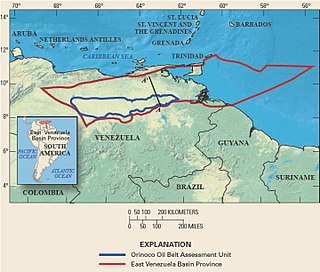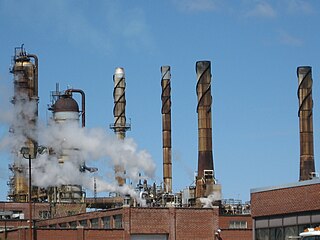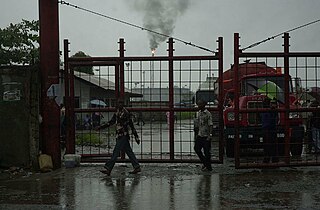
Minatitlán is a city in the Mexican state of Veracruz. It is located in the southeastern part of the state, in the Olmeca region, to the north of the Isthmus of Tehuantepec, along the Coatzacoalcos River.

Repsol S.A. is a Spanish multinational energy and petrochemical company based in Madrid. It is engaged in worldwide upstream and downstream activities. In the 2022 Forbes Global 2000, Repsol was ranked as the 320th-largest public company in the world. As of 2022, it has 24,000 employees worldwide.

The Orinoco Belt is a territory in the southern strip of the eastern Orinoco River Basin in Venezuela which overlies the world's largest deposits of petroleum. Its local Spanish name is Faja Petrolífera del Orinoco.

Kochi Refinery Limited (KRL) is a crude oil refinery in the city of Kochi in Kerala, India. It is the largest public sector refinery in India with a production capacity of 15.5 million tonnes per year. Formerly known as Cochin Refineries Limited and later renamed as Kochi Refineries Limited, it was acquired by Bharat Petroleum Corporation Limited in the year 2006. The refinery is situated at Ambalamugal, around 12 km (7.5 mi) east of the city centre.
TNK-BP was a major vertically integrated Russian oil company headquartered in Moscow. It was Russia's third-largest oil producer and among the ten largest private oil companies in the world. In 2013 it was acquired by Russian oil company Rosneft.

National Iranian Oil Refining and Distribution Company (NIORDC) is part of the Ministry of Petroleum of Iran. NIORDC was established on 8 March 1991 and undertook to perform all operations relating to refining and distribution of oil products.

Ecopetrol, formerly known as Empresa Colombiana de Petróleos S.A. is the largest and primary petroleum company in Colombia. As a result of its continuous growth, Ecopetrol forms part of the Fortune Global 500 and was ranked 346. In the 2020 Forbes Global 2000, Ecopetrol was ranked as the 313th -largest public company in the world. It was ranked 303 in 2012 by CNN Money.

Petróleos del Perú, better known as Petroperú, is a Peruvian state-owned enterprise and private law dedicated to the transportation, refining, distribution, and commercialization of fuels and other petroleum products. It has been owned by the State of Peru since 1969, is considered among the taxpayers to the treasury, and currently employs more than 2,500 people. Petroperú invests in education, health, and other sustainable development projects throughout the Peruvian territory.

The Transandino pipeline is a 305-kilometre (190 mi) long crude oil pipeline, which transports oil from Orito, in the Department of Putumayo, to the Pacific port of Tumaco in the Department of Nariño, Colombia. The pipeline was built in 1969 with diameters of 10 inches (250 mm), 14 inches (360 mm) and 18 inches (460 mm). There are four pump stations and four reduce pressure stations. The pipeline has the capacity of 190,000 barrels per day (30,000 m3/d). It is operated by Ecopetrol.
Villa Elisa Refinery is an oil refinery located in Villa Elisa, 15 km (9.3 mi) from Asunción close to the Paraguay River and is owned by the Paraguay national oil company Petróleos Paraguayos. The refinery is capable of processing 7,500 barrels (1,190 m3) of crude oil per day and produces lubricants, diesel, kerosene, naphtha and LPG.

The Chevron Richmond Refinery is a 2,900-acre (1,200 ha) petroleum refinery in Richmond, California, on San Francisco Bay. It is owned and operated by Chevron Corporation and employs more than 1,200 workers, making it the city's largest employer. The refinery processes approximately 240,000 barrels (38,000 m3) of crude oil a day in the manufacture of petroleum products and other chemicals. The refinery's primary products are motor gasoline, jet fuel, diesel fuel and lubricants.

The Montreal East Refinery was an oil refinery located in Montreal East and formerly Shell Canada's largest refinery. In October 2010, refinery operations permanently ceased and the facility was subsequently converted into a storage terminal.

The Paraguaná Refinery Complex is a crude oil refinery complex in Venezuela. It is considered the world's second largest refinery complex, just after Jamnagar Refinery (India). The Paraguaná Refinery Complex was created by the fusion of Amuay Refinery, Bajo Grande Refinery and Cardón Refinery. The Paraguana Refinery Complex is still the largest refinery in the Western Hemisphere. As of 2012, it refined 955 thousand barrels per day (151,800 m3/d). The complex is located in the Paraguaná Peninsula in Falcón state and the western coast of Lake Maracaibo in the Zulia state. The complex accounts for 71% of the refining capacity of Venezuela and it belongs to the state-owned company Petróleos de Venezuela (PDVSA).

Mineral industry of Colombia refers to the extraction of valuable minerals or other geological materials in Colombia. Colombia is well-endowed with minerals and energy resources. It has the largest coal reserves in Latin America, and is second to Brazil in hydroelectric potential. Estimates of petroleum reserves in 1995 were 3.1 billion barrels (490,000,000 m3). Colombia also possesses significant amounts of nickel and gold. Other important metals included platinum and silver, which were extracted in much smaller quantities. Colombia also produces copper, small amounts of iron ore, and bauxite. Nonmetallic mined minerals include salt, limestone, sulfur, gypsum, dolomite, barite, feldspar, clay, magnetite, mica, talcum, and marble. Colombia also produces most of the world's emeralds. Despite the variety of minerals available for exploitation, Colombia still had to import substances such as iron, copper, and aluminum to meet its industrial needs.

The Ocensa pipeline is a crude oil pipeline in Colombia. It starts on the Cusiana and Cupiagua oilfields and runs to Coveñas on Colombia's Caribbean coastline. It is owned by the consortium of Ecopetrol, BP, Total S.A., Petrominerales and Triton Colombia.

The Tema Oil Refinery (TOR) is one of two crude oil refineries in Ghana. In 1977, the Government of Ghana became the sole shareholder. The name of the refinery was changed to the Tema Oil Refinery in 1991. The refinery was first named the Ghanaian Italian Petroleum Company (GHAIP).
The Rubiales Oil Field is an oil field located in the Llanos Basin, Meta Department, Colombia. It was discovered in 1981 and was first developed, operated and owned by Pacific Rubiales Energy. The field produces heavy oil (11.3-14.5° API gravity) from the C7 unit of the Carbonera Formation. The porosity of the reservoir formation is between 28 and 33% and the permeability ranges from 3 to 5 Darcies. In 2008, 22.817.163 barrels were produced from the field. The total proven reserves of the Rubiales oil field are 4.38 billion barrels (588×106tonnes), and production in 2017 is 132,000 barrels per day (21,000 m3/d).

The Port Harcourt Refining Company,, is a Nigeria-based oil and gas company primarily specializing in the refining of crude oil into petroleum products. It is headquartered in Port Harcourt metropolitan area of Rivers State, southeastern Nigeria. The company is a subsidiary of the Nigerian National Petroleum Corporation (NNPC).

The Talara Refinery is an oil refinery in Pariñas, Talara, Piura, Peru that belongs to the state company Petroperú.
















